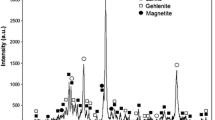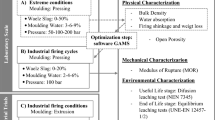Abstract
A cupola furnace is the most frequently used furnace aggregate for cast iron production. A by-product of the production of cast iron in cupola furnaces is cupola slag. Its amount is 40–80 kg per 1 tonne of the produced cast iron, and that is one of the reasons why this material is not as favoured as, for example, the blast-furnace slag. The purpose of this article is to provide the basic information on the formation of slag in a cupola furnace, and its chemical composition, structure and current potential applications. The greatest potential for the use of cupola slag is in the building industry; therefore, a section of the present article deals with the property that plays an important role particularly with regard to the use of slags in the building industry, i.e. the slag hydraulicity. The achieved results indicate that the hydraulicity of the cupola slag is incomparable with the hydraulicity of the blast-furnace slag; this may be associated with the problems that arise when the slag of this type is used in the building industry. The authors used the air-cooled as well as granulated slags from cupola furnaces in the production of concrete that was made from the slags alone. While the air-cooled slag may be used as a partial replacement for the blast-furnace slag in concrete mixtures, the use of granulated slag from cupola furnaces as a replacement for granulated blast-furnace slag in cement-free concrete has not proven to perform well.








Similar content being viewed by others
References
M. Reuter, Y. **ao, U. Boin, Recycling and environmental issues of metallurgical slags and salts fluxes VII, in International Conference on Molten Slags Fluxes and Salts, The South African Institute of Mining and Metallurgy (2004), https://scholar.google.sk/scholar?hl=sk&as_sdt=0%2C5&q=%5B1%5D%09Reuter+M.%2C+**ao%2CY.%2C+Boin%2CU.%3A+REcycling+and+environmental+issues+of+metallurgical+slags+and+salts+fluxes.+VII.+International+Conference+on+Molten+Slags+Fluxes+and+Salts%2C+The+South+African+Institute+of+Mining+and+Metallurgy+%2C+2004%2C+349+%E2%80%93+356&btnG=
V. Ramachan, The treatment and minimization of waste. J. Met. February (1995), https://scholar.google.sk/scholar?hl=sk&as_sdt=0%2C5&q=%5B3%5D%09RAMACHANDRAN%2C+V.+The+treatment+and+minimization+of+waste.+J.+Met+1995%2C+February%2C+pp.+50%E2%80%9351.&btnG=
R. Boom, K.C. Mills, S. Riaz., Recent trends in research on slags, in Proceedings of the Sixth International Conference on Molten Slags, Fluxes and Salts, Stockholm, Sweden–Helsinki, Finland, 12–17 June, CD Rom-paper 110 (2000). https://search.proquest.com/docview/236404332?pq-origsite=gscholar
S. Hami, Slag: product or waste—the present situation, in EUROSLAG, Slag—Providing Solution for Global and other Markets, 4th European Slag Conference. Proceeding, Euroslag Publication No. 3 (2005)
W. Heinbichner, G. Wolf, A. Huster, A particle—resolved CFD model of the combustion and gasification processes of coke. InterMetalcast 12, 113 (2018). https://doi.org/10.1007/s40962-017-0147-6
W. Heinbichner, A particle-resolved CFD study of combustion and gasification processes in a coke-fired furnace. InterMetalcast 12, 126 (2018). https://doi.org/10.1007/s40962-017-0150-y
J. Ladomersky, I. Janotka, E. Hroncova, I. Najdena, One-year properties of concrete with partial substitution of natural aggregate by cupola foundry slag, in JCLEPRO, 131 (2016), https://www.sciencedirect.com/science/article/pii/S0959652616303778
J. Ladomersky, E. Nosal, E. Hroncova, Využitie trosky zvýroby liatiny pre výrobu betónu (Utilization of slag from cast iron production in concrete production). Waste forum 3, 125–132 (2009), www.wasteforum.cz/cisla/WF_2_2009.pdf
J. Koren, I. Jelc, Optimalizácia tavenia liatiny (Optimalization of cat iron melting) (Alfa, Bratislava, 1988), pp. 70–90
Z. Gedeonova, I. Jelc, Metalurgia liatin (Cast iron metallurgy) (HF TU, Kosice, 2000), pp. 78–93
A. Pribulova, P. Gengel, M. Bartosova, Odpady z výroby oceľových a liatinových odliatkov (Wastes from steel and cast iron castings production), TUKE, HF, Kosice, 2010), pp. 79–87
R.E. Aristizábal, P.A. Pérez, S. Katz et al., Studies of a quenched cupola. InterMetalcast 8, 3 (2014). https://doi.org/10.1007/BF03355586
H. Sun, K. Mori, R. Pehlke, Chemical reactions of liquid metal in slag layer and well of cupola, Part II: Prediction of metal composition. Trans. Am. Found. Soc. 104, 595–604 (1996)
L. Zeghichi. The effect of replacement of naturals aggregates by slag products on the strength of concrete. Asian J. Civil Eng. (Build. Housing) 7, 1 (2006). https://www.sid.ir/FileServer/JE/103820060104
D.M. Ceccato, A.B. Masuero, C.A. Moraes, A.C.F. Vilela (2009). The recycling of Foundry granulated slag (FGS) as a partial substitute of cement in concrete. Rev. Mater. 14, 1 (2009) http://www.scielo.br/scielo.php?pid=S1517-70762009000100008&script=sci_arttext&tlng=es
H. Sun, K. Mori, R. Pehlke, Chemical reactions of liquid metal in slag layer and well of cupola Part I: Development of kinetic model. Trans. Am. Found. Soc. 104, 75–78 (1996)
A. Chinwuba, M. Grace, Partial replacement of portland cement by granulated cupola slag—sustainable option for concrete of low permeability, civil and environmental research, 13 (2014). http://citeseerx.ist.psu.edu/viewdoc/download?doi=10.1.1.901.3972&rep=rep1&type
R. Balaraman, S. Ligoria, Utilization of cupola slag in concrete as fine and coarse aggregate, in IJCIET 8, 6 (2015). http://www.iaeme.com/MasterAdmin/UploadFolder/IJCIET_06_08_002/IJCIET_06_08_002.pd
H.G. Smolczyk, The effect of chemistry of slag on the strength of blast furnace cements. Zem.-Kalk-Gips 31, 294–296 (1978)
J. Vlcek, R. Svrcinova, J. Burda, M. Topinkova, M. Klarova, H. Ovcacíkova, D. Jancar, M. Velicka, Hydraulic properties of ladle slags. Metalurgija 55, 3 (2016)
R. Balaraman, N.S. Elangoval, Behaviour of cuplola slag in concrete as partial replacement with combination of fine and coarse aggregate. Taga J. 14 (2018) http://www.tagajournal.com/gallery/v14.91.pdf
R. Balaraman, S. Ligoria, Utilization of Cupola slag in concrete as fine and coarse aggregate, in IJCIET, 8, 6 (2015) http://www.iaeme.com/MasterAdmin/UploadFolder/IJCIET_06_08_002/IJCIET_06_08_002.pd
S.M. Cramer, P. Bakke, Potential use of cupola slag as road construction material, in AFS International Cupola Conference, pp. 113–122 (1994)
J.O. Afolayan, S.A. Alabi, Investigation on the potential of Cupola furnace slag in concrete. Int. J. Integr. Eng. 5, 2 (2013). http://penerbit.uthm.edu.my/ojs/index.php/ijie/article/view/590/551
C.R. Loper Jr., J.O. Kristiansen, A.L. Haase, H.R. Bigge, F.A. Quilling, R.S. Krouse, A.K. Chowdhury, Beneficial reuse of desulfurization slag. Am. Found. Soc. Trans. 104, 29–32 (1996)
D. Baricova, A. Pribulova, P. Demeter, B. Bulko, P. Futas, Analysis of metallurgical slags utilization in the road engineering, in SGEM 2011, 11th International Multidisciplinary Scientific GeoConference proceedings, vol. 3, pp. 785–791 (2011)
D. Baricova, P. Demeter, Vysokopecna troska a možnosti jej zužitkovania (Blast furnace slag and possibilities of its utilization). in Quo Vadis Foundry Conference, pp. 4–9 (2010)
Funding
This work was supported by the Scientific Grant Agency of the Ministry of Education of the Slovak Republic No. VEGA1/0073/17, and APVV-16-0485.
Author information
Authors and Affiliations
Corresponding author
Additional information
Publisher's Note
Springer Nature remains neutral with regard to jurisdictional claims in published maps and institutional affiliations.
This paper is an invited submission to IJMC selected from presentations at the 73rd World Foundry Congress, held September 23 to 27, 2018, in Krakow, Poland, and has been expanded from the original presentation.
Rights and permissions
About this article
Cite this article
Pribulova, A., Baricova, D., Futas, P. et al. Cupola Furnace Slag: Its Origin, Properties and Utilization. Inter Metalcast 13, 627–640 (2019). https://doi.org/10.1007/s40962-019-00314-3
Published:
Issue Date:
DOI: https://doi.org/10.1007/s40962-019-00314-3




